

I have two more pictures of the Apennines here.
Move your mouse over the picture to see the names of the various features.
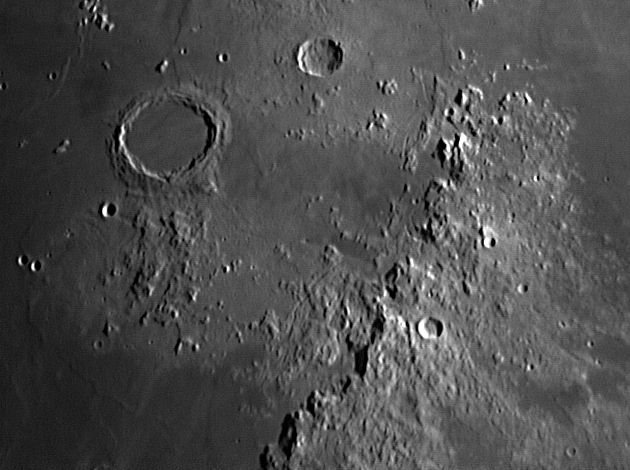 This picture of Archimedes and the Apennine mountains was taken in what would be the late morning on the Moon. Archimedes is the largest crater here, 85 Km in diameter and 2100 metres deep. It is fairly old by lunar standards at about 3,500 million years and it has been flooded by lava as attested to by the flat floor and lack of a central mountain. Autolycus, on the other hand, is less than 1,000 million years old, is 41 Km in diameter and 3400 metres deep. It has central mountains but they don't show up well in this picture due to the high Sun. The Apennine mountains themselves form the south-western rim of the Mare Imbrium. They are 980 km long, 100 Km wide, rise to 5400 metres (Mons Huygens) and are some 3,800 million years old. At the northern end of the range, between Mons Hadley (4800 metres) and Mons Hadley Delta is the landing site of Apollo 15 close to Hadley Rille which doesn't show up in this picture (but see below and my Apollo 15 page). I was pleased at the number of mountains here for which I was able to find names, along with two Laci (Lakes) and the charmingly named Palus Pudridinis (the Putrid Marsh).
This picture of Archimedes and the Apennine mountains was taken in what would be the late morning on the Moon. Archimedes is the largest crater here, 85 Km in diameter and 2100 metres deep. It is fairly old by lunar standards at about 3,500 million years and it has been flooded by lava as attested to by the flat floor and lack of a central mountain. Autolycus, on the other hand, is less than 1,000 million years old, is 41 Km in diameter and 3400 metres deep. It has central mountains but they don't show up well in this picture due to the high Sun. The Apennine mountains themselves form the south-western rim of the Mare Imbrium. They are 980 km long, 100 Km wide, rise to 5400 metres (Mons Huygens) and are some 3,800 million years old. At the northern end of the range, between Mons Hadley (4800 metres) and Mons Hadley Delta is the landing site of Apollo 15 close to Hadley Rille which doesn't show up in this picture (but see below and my Apollo 15 page). I was pleased at the number of mountains here for which I was able to find names, along with two Laci (Lakes) and the charmingly named Palus Pudridinis (the Putrid Marsh).
The scale markers are approximately 100 km long north and east.
The picture was taken with a ToUcam attached to my LX200 on 5th June 2006, when the Moon was 9.0 days old.
Date and Time: 5th June 2006 17:56 UT
Camera: ToUcam 740K
Telescope: LX200 with IR-pass filter
Capture: K3CCDTools. Low gamma, 1/33", 22% gain, 627 frames
Processing: Registax. 105 frames stacked. Wavelets 1 = 10, 2 = 5, histogram 30-200
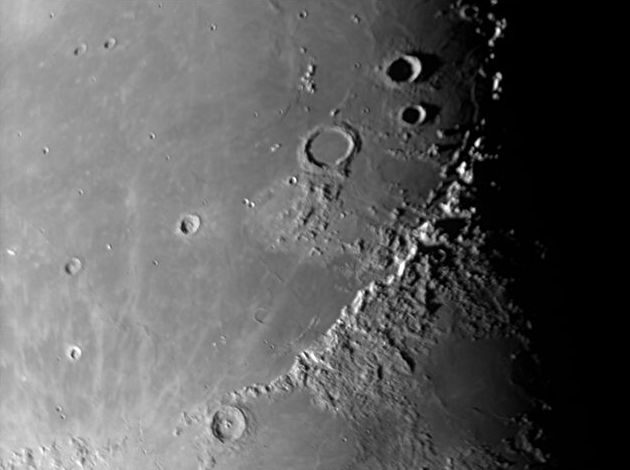
|
A wider-angled view of the mountains obtained by using a focal reducer on the LX200. It shows the Apennines as the south-eastern rim of the Imbrium basin together with the more recent craters nearby. The scale markers are approximately 100 Km north and east. An even wider-angled picture can be see here. This picture was taken on 14th October 2006 when the Moon as 22.3 days old. Date and Time: 14th October 2006 03:19 UT Camera: Atik 1-HS Telescope: LX200 with IR-block and Neodymium filters Capture: K3CCDTools. High gamma, 1/100", 15% gain, 599 frames Processing: Registax. 6 alignment points, 538 frames stacked. Gaussian wavelet 1 = 20, 2 = 10, histogram 0-170 |
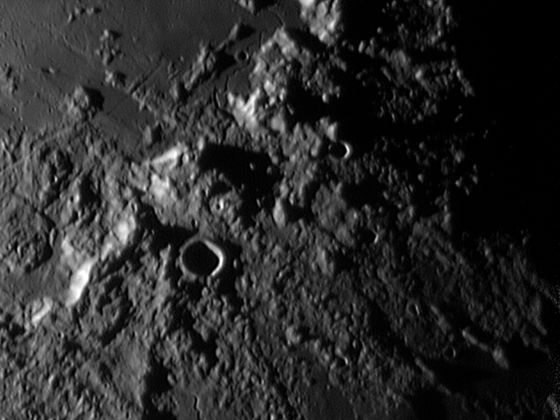
|
In this closer view of the Apennine Mountains, the Hadley Rille, visited by the Apollo-15 Astronauts in 1971,
can be seen at the top of the picture. The largest crater here is Conon, 22 Km in diameter
and 2300 metres deep. Aratus is smaller at 10 Km, bowl shaped and 1860 metres deep.
Both are relatively young at less than 1,100 million years. The picture was taken with a ToUcam attached to my LX200 with a X2 adaptor lens on 6th September 2004 when the Moon was 21.8 days old. Date and Time: 6th September 2004 04:24 UT Camera: ToUcam 740K Telescope: LX200 with X2 lens Capture: K3CCDTools. High gamma, 1/50", 23% gain, 303 frames Processing: Registax. 110 frames stacked. Wavelet 1,2 = 10 |
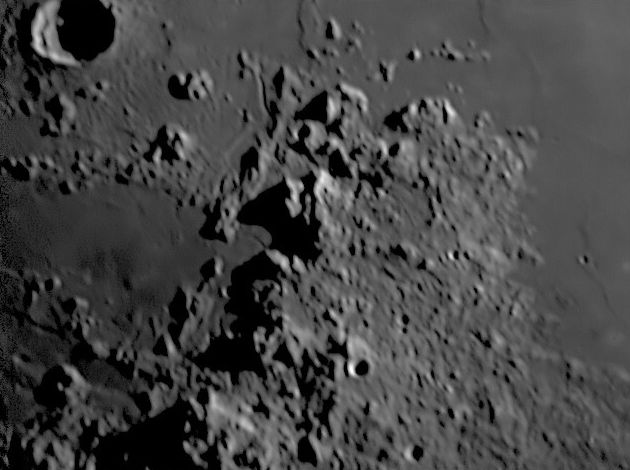
|
This is an enlarged view taken a couple of hours after the picture above. The picture was taken with a ToUcam attached to my LX200 with a X2 lens on 6th May 2006 when the Moon was 7.9 days old. Date and Time: 6th May 2006 22:18 UT Camera: ToUcam 740K Telescope: LX200 with X2 lens and IR-pass filter Capture: K3CCDTools. 50% gamma, 1/33", 0% gain, 603 frames Processing: Registax. 205 frames stacked. Wavelet 1,2 = 10, gamma 2.0 Noise reduction in NeatImage. |
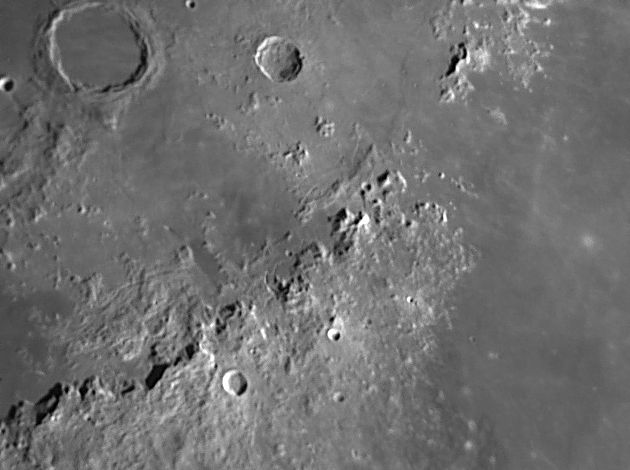
|
This picture is very similar to the one at the top of this page but taken in white light with a DMK camera. It is also somewhat less aggressively processed. This picture is one of a set of 5 that form a mosaic from Copernicus along the Apennines to the Caucasus, which may be seen here. The scale markers are approximately 100 Km north and west. The picture was taken with a DMK camera fitted to my LX200 on 27th December 2017 when the Moon was 8.8 days old. Lunar Phase: 72.3° Colongitude: 24.7° Libration: +6° 56' in latitude, -7° 49' in longitude Date and Time: 27th December 2017 19:07 UT Camera: DMK 21AF04 Telescope: LX200-10 with ADC* Capture: ICCapture. 1/618", gain 727, 1800 frames Processing: Registax6. 16 alignment points, 100 frames stacked per point. Wavelet 1,2 = 5, gamma 1.3 *ADC: Atmospheric Dispersion Corrector |
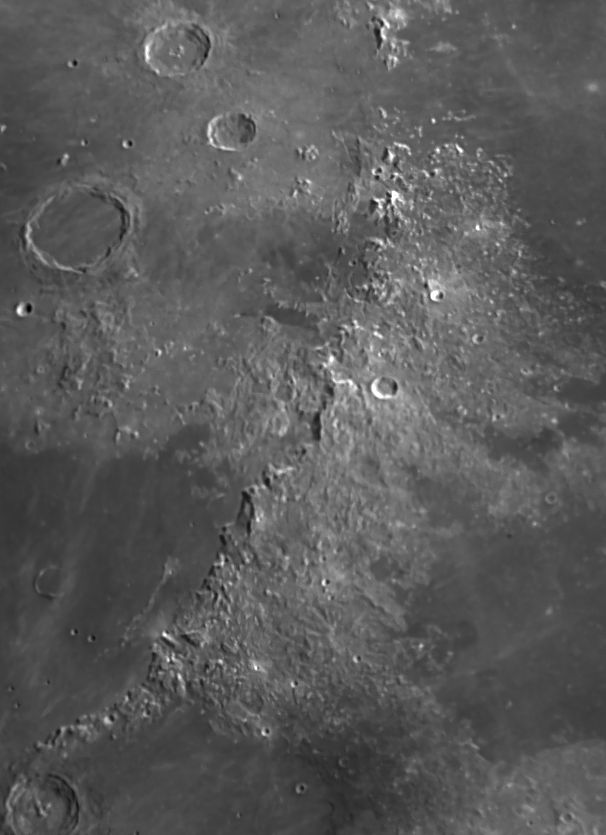
|
This picture is a mosaic of two frames taken on lunar day 10. This range contains the highest mountains on the visible side of the Moon. I have indicated all of the named mountains in the places officially assigned to them. However, examination of the LRO altimeter data* shows that these are not always the highest points in the immediate area. For example Mons Bradley is officially the ridge indicated but the ground rises at the northern end to some 500 metres higher than the ridge. * http://www.quickmap.lroc.asu.edu The picture was taken with a DMK camera fitted to my LX200 on 11th May 2022 when the Moon was 10.1 days old. The scale markers are approximately 100 Km north and west. Date and Time: 11 May 2022 21:32 and 22:35 UT Lunar Phase: 56.4° Colongitude: 40.9° Libration: -5° 5' in latitude, -7° 6' in longitude Camera: DMK 21AF04 Telescope: LX200-10 Capture: ICCapture. 1/500", gain 910, 3401 frames (both parts) Processing: Registax5. 1991 and 1913 frames stacked. Wavelets 1,2 = 10 Focus Magic 2 |
Home Lunar Index